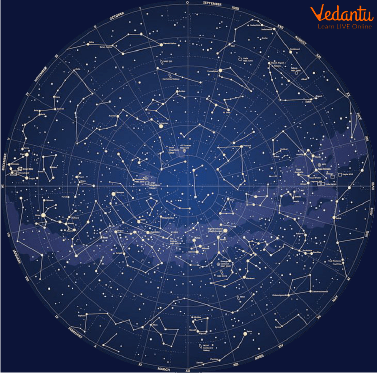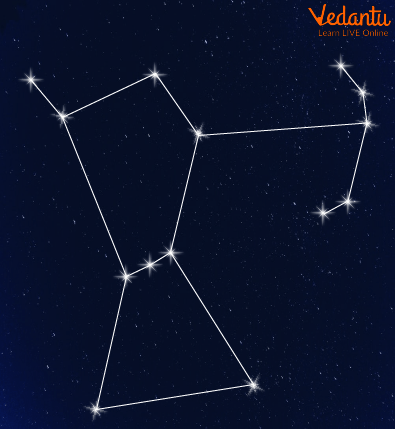




What Are Constellations? Simple Guide for Kids with Examples
A star is created in space when various gases are united by the gravitational effect and by the fusion of hydrogen and helium atoms. Every star has a mass directly related to its gravity. This implies that the larger the star, the less time it will live (stars with a lot of mass use more fuel).
If the stars are hot, they tend towards a bluish colouration and if they are cooler, they tend towards red. When you look up at the sky and see a pattern then a question may arise in your brain, what are constellations. Let’s read below.
What are Constellations?
A constellation occurs when a group of stars is located in the sky in such a way that they produce an image. Keep in mind that the observation of the sky is different depending on the place of observation and the season of the year.
The contemplation of the stars has been carried out since ancient times. Thus, the Babylonians, the Egyptians, or the Greeks of the ancient world called constellations the groups of stars that they associated with some supernatural divinity. The Greeks named a large part of the constellations, especially those that are observed from the Northern Hemisphere.
How Many Constellations are There?
Now let us talk about how many constellations are there in the sky. Astronomers officially recognize 88 constellations that cover the entire sky in the Northern and Southern Hemispheres. Currently, 14 men and women, 9 birds, two insects, 19 land animals, 10 aquatic creatures, two centaurs, a scalp (Coma Berenices), a snake, a dragon, a flying horse, a river, and 29 inanimate objects, are represented in the night sky. It should be noted that the total number of constellations exceeds 88 because some constellations of stars include more than one creature.

The Constellations
It is important to realize that the vast majority of star patterns bear little or no resemblance to the figures they are supposed to represent and are named after. The ancient constellation builders probably intended them to be symbolic, not literal, representations of their favourite animals or legendary heroes, i.e. a kind of celestial "Hall of Fame".
Types of Constellation
Circumpolar Constellations
They can be seen in the Northern Hemisphere throughout the year, for example, Ursa Major, Ursa Minor, Giraffe, or Dragon.
Spring Constellations
It could be said that the sky expands and we can enjoy more galaxies during this time of year, such as Crater, Hydra, or Leo.
Summer Constellations
The earth is orbiting looking towards the interior of the Milky Way, therefore, we can enjoy: Swan, Arrow, or Horse constellations among others.
Autumn Constellations
Now the earth does not look towards the Milky Way but towards the interior of the dark universe. Thus, we will be able to see galaxies that are incredibly far away, such as Andromeda, Aquarius, or Pegasus.
Winter Constellations
The Milky Way is at the top of the sky at dusk and there are plenty of constellations to look out for, weather permitting, such as Coachman, Hare, or Gemini.
It should be noted that the constellations seen from the Northern Hemisphere are not the same as those seen from the Southern Hemisphere.
Orion Constellation
The most conspicuous example of a constellation is Orion which can be seen from anywhere on the Earth. This figure unites bright points of light forming the well-known "Belt of Orion", also called "The Three Wise Men" because there are three outstanding stars (Mintaka, Alnilam, and Alnitak).

Orion Constellation
This image complies with our terrestrial perspective since, if this constellation were seen from space, it would be possible to perceive that its stars move around due to their varying distances from the planet.
Orion's shape resembles that of an hourglass surmounted by two upper stars. It is best known in the entire sky and is located near the constellation of the river Eridanus and the constellation of Taurus.
The complex of clouds that make up Orion is a gigantic structure of hydrogen, dust, plasma, and nascent stars and in terms of its location, it is located at a distance of 1500 light-years from Earth.
Summary
A constellation is a collection of stars in the night sky that resembles a known object or design. They might take the form of humans, animals, or things. Numerous human-shaped designs bear the names of legendary characters from antiquity.
Numerous applications of constellations exist in astronomy, navigation, agriculture, and literature. In the sky, there are 88 main star constellations. You can't see them all at once, and some of them, particularly the brightest ones during the day, are almost hard to view without a telescope.
FAQs on Constellations for Kids: Meaning, Facts & Night Sky Fun
1. What is a constellation, explained in simple terms for kids?
A constellation is a group of stars that form a recognisable pattern or picture in the night sky. Think of it like a giant 'connect-the-dots' puzzle using stars. Ancient people imagined these patterns looked like animals, heroes, or objects and gave them names, such as Orion the Hunter or Leo the Lion.
2. What are some of the most famous constellations I can see in the sky?
Some of the most famous and easy-to-spot constellations depend on your location and the time of year, but here are a few well-known ones:
- Ursa Major (The Great Bear): This large constellation contains the famous 'Big Dipper' asterism, which looks like a large spoon or saucepan.
- Orion (The Hunter): Easily recognisable by the three bright stars in a row that form Orion's belt.
- Cassiopeia (The Queen): This constellation forms a distinct 'W' or 'M' shape in the sky.
- Ursa Minor (The Little Bear): This constellation contains Polaris, the North Star, at the end of its handle.
3. Why were constellations so important to people in ancient times?
Constellations were extremely important to ancient civilisations for several practical reasons. They used them as a:
- Calendar: The appearance of certain constellations signalled the changing of seasons, helping farmers know when to plant seeds and when to harvest crops.
- Navigation Tool: Sailors and travellers used constellations, especially the ones around the North Star (Polaris), to find their way across vast oceans and deserts at night.
- Storytelling Device: The patterns in the stars were used to tell stories about gods, goddesses, heroes, and mythical beasts, passing down culture and legends through generations.
4. Are the stars in a constellation actually close to each other in space?
No, this is a common misconception. The stars that make up a constellation may look close together from our viewpoint on Earth, but in three-dimensional space, they are often incredibly far apart from each other. Some stars in a single constellation might be relatively close to us, while others are many, many light-years further away.
5. How can I start learning to find constellations in the night sky?
Finding constellations is a fun activity! To start, find a location away from bright city lights on a clear, moonless night. Let your eyes adjust to the darkness for about 15-20 minutes. The easiest way to begin is by looking for a very bright and distinct pattern, like the Big Dipper in the Ursa Major constellation or the three stars of Orion's Belt. Using a star chart or a beginner-friendly astronomy app can also help you identify what you are seeing.
6. Why is the Ursa Major constellation so helpful for finding the Pole Star?
Ursa Major, or the Great Bear, is very helpful because it contains an easy-to-spot pattern called the Big Dipper. The two stars at the end of the Big Dipper's 'bowl' are known as the 'pointer stars'. If you imagine a straight line extending from these two stars, it points almost directly to Polaris, the North Star. Since Polaris is always in the same spot in the northern sky, finding it using Ursa Major is a reliable way to determine which direction is north.
7. Do constellations look the same forever?
No, they do not. While constellations appear fixed during a human lifetime, the stars that form them are constantly moving through space. Over very long periods—tens of thousands of years—this movement, known as proper motion, will cause the familiar shapes of constellations like Orion or the Big Dipper to slowly change and eventually become unrecognisable.









